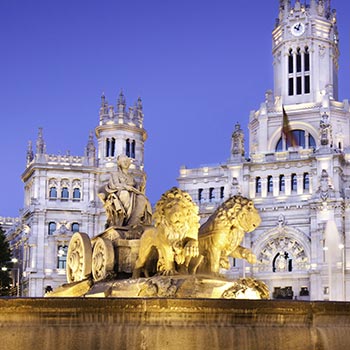Chemistry
Engineering & Social Sciences Program
Madrid, Spain
Dates: 8/30/25 - 12/20/25

Chemistry
OVERVIEW
CEA CAPA Partner Institution: Universidad Carlos III de Madrid
Location: Madrid, Spain
Primary Subject Area: Chemistry
Instruction in: English
Course Code: 15528
Transcript Source: Partner Institution
Course Details: Level 100
Recommended Semester Credits: 3
Contact Hours: 42
Prerequisites: High school chemistry
DESCRIPTION
0. Preliminary concepts. What is chemistry? Definitions. Units. Standard conditions. Atoms. Molecules. Mole. Molecular mass. Chemical equations. Reactions in aqueous media: acids and bases, redox reactions
1. Atoms. Ancient ideas about atoms. Bohr¿s model. Experiments and concepts that led to Bohr¿s model. Foundations of quantum theory. Hydrogen atom: quantum numbers, electronic configuration, atomic orbitals, energy of hydrogen atom. Multielectronic atoms. Periodic table and periodic properties
2. Molecules. Preliminaries on covalent bonding theory: Lewis structures, molecular geometry, bond parameters, ionic character of bonds. Introduction to the theory of molecular orbitals. Visualization of molecular orbitals from valence bond theory. Simple energy diagrams. Hybridization. Coordination compounds. Intermolecular forces: coulombic and polarization forces. Hydrogen bonding. The structure of water.
3. States of matter. Aggregation states: long and short range order. Solids: ionic, metals, covalent, molecular. Gases: kinetic theory of gases, equation of state. Real gases: liquefaction. Liquids: viscosity, surface tension. Liquid crystals: membranes. Liquid vapor equilibrium: Clausius equation, equilibrium phase diagrams. Solutions: solubility, colligative properties of electrolytes and non-electrolytes.
4. Thermochemistry. Definitions: system, state variable, state function, heat and work, reversible process. First law of thermodynamics: enthalpy, heat capacity, reaction enthalpy, temperature dependence of reaction enthalpy. Second law of thermodynamics: entropy, reaction entropy, temperature dependence of reaction entropy. Third law of thermodynamics. Gibbs free energy: spontaneity, standard free energy of formation, relation between free energy and chemical equilibrium for ideal gas mixtures.
5. Equilibrium reactions. Gases: equilibrium constant, heterogeneous equilibria, factors affecting chemical equilibrium(pressure, temperature, concentration, inert gases, temperature). Arrhenius, Brönsted-Lowry and Lewis theories of acids and bases. Water self-ionization. Strength of acids and bases. Conjugate acids and bases. Hydrolysis. Buffers. Titration. Solubility. Electrochemical reactions: reducing and oxidizing agents. Balance of redox reactions. Electrochemical cells: conventions, galvanic potential, standard electrode potential, free energy and electrode potential. Electrolytic cells: Faraday¿s laws.
6. Chemical kinetics. Reaction rate law. Differential and integrated reaction rates. Reaction mechanism: elemental process, molecularity, limiting reactant, reaction intermediate. Rate constants and equilibrium constants. Collision theory. Transition state theory. Catalysis: homogeneous and heterogeneous. Enzymatic catalysis: Michaelis-Menten kinetics.
7. Introduction to organic chemistry. Naming organic compounds. Empirical, molecular and structural formula. Conformational isomerism. Stereoisomerism: optical activity. Fisher projections. Molecular structure and intermolecular forces. Electronic shifts on ¿ and ¿ bonds. Aromaticity. Substitution effects in ¿ systems. Intermediates: radicals, carbocations, carbanions. Intermediate stability: induction, resonance, hyperconjugation. Organic reactions: classification and definitions. Substitution. Addition. Elimination. Transposition. Condensation.
8. Alkanes: reactivity. Cycloalkanes: synthesis. Alkenes: isomerism, terpenes, addition reactions (Markovnikov), oxidation and autoxidation reactions. Alkynes: electrophilic addition reactions. Aromatic hydrocarbons: addition reactions and stability, electrophilic substitution. Benzene derivatives. Alcohols and phenols: acidity, electrophilic substitution, oxidation, stability of phenoxy radicals. Ethers: reactivity and synthesis. Thiols: reactivity and synthesis. Carbonyl compounds: resonance, oxidation and reduction, nucleophilic addition, synthesis. Carboxylic acids: stability of carboxylate anion, acidity, nuclephilic substitution, sy
1. Atoms. Ancient ideas about atoms. Bohr¿s model. Experiments and concepts that led to Bohr¿s model. Foundations of quantum theory. Hydrogen atom: quantum numbers, electronic configuration, atomic orbitals, energy of hydrogen atom. Multielectronic atoms. Periodic table and periodic properties
2. Molecules. Preliminaries on covalent bonding theory: Lewis structures, molecular geometry, bond parameters, ionic character of bonds. Introduction to the theory of molecular orbitals. Visualization of molecular orbitals from valence bond theory. Simple energy diagrams. Hybridization. Coordination compounds. Intermolecular forces: coulombic and polarization forces. Hydrogen bonding. The structure of water.
3. States of matter. Aggregation states: long and short range order. Solids: ionic, metals, covalent, molecular. Gases: kinetic theory of gases, equation of state. Real gases: liquefaction. Liquids: viscosity, surface tension. Liquid crystals: membranes. Liquid vapor equilibrium: Clausius equation, equilibrium phase diagrams. Solutions: solubility, colligative properties of electrolytes and non-electrolytes.
4. Thermochemistry. Definitions: system, state variable, state function, heat and work, reversible process. First law of thermodynamics: enthalpy, heat capacity, reaction enthalpy, temperature dependence of reaction enthalpy. Second law of thermodynamics: entropy, reaction entropy, temperature dependence of reaction entropy. Third law of thermodynamics. Gibbs free energy: spontaneity, standard free energy of formation, relation between free energy and chemical equilibrium for ideal gas mixtures.
5. Equilibrium reactions. Gases: equilibrium constant, heterogeneous equilibria, factors affecting chemical equilibrium(pressure, temperature, concentration, inert gases, temperature). Arrhenius, Brönsted-Lowry and Lewis theories of acids and bases. Water self-ionization. Strength of acids and bases. Conjugate acids and bases. Hydrolysis. Buffers. Titration. Solubility. Electrochemical reactions: reducing and oxidizing agents. Balance of redox reactions. Electrochemical cells: conventions, galvanic potential, standard electrode potential, free energy and electrode potential. Electrolytic cells: Faraday¿s laws.
6. Chemical kinetics. Reaction rate law. Differential and integrated reaction rates. Reaction mechanism: elemental process, molecularity, limiting reactant, reaction intermediate. Rate constants and equilibrium constants. Collision theory. Transition state theory. Catalysis: homogeneous and heterogeneous. Enzymatic catalysis: Michaelis-Menten kinetics.
7. Introduction to organic chemistry. Naming organic compounds. Empirical, molecular and structural formula. Conformational isomerism. Stereoisomerism: optical activity. Fisher projections. Molecular structure and intermolecular forces. Electronic shifts on ¿ and ¿ bonds. Aromaticity. Substitution effects in ¿ systems. Intermediates: radicals, carbocations, carbanions. Intermediate stability: induction, resonance, hyperconjugation. Organic reactions: classification and definitions. Substitution. Addition. Elimination. Transposition. Condensation.
8. Alkanes: reactivity. Cycloalkanes: synthesis. Alkenes: isomerism, terpenes, addition reactions (Markovnikov), oxidation and autoxidation reactions. Alkynes: electrophilic addition reactions. Aromatic hydrocarbons: addition reactions and stability, electrophilic substitution. Benzene derivatives. Alcohols and phenols: acidity, electrophilic substitution, oxidation, stability of phenoxy radicals. Ethers: reactivity and synthesis. Thiols: reactivity and synthesis. Carbonyl compounds: resonance, oxidation and reduction, nucleophilic addition, synthesis. Carboxylic acids: stability of carboxylate anion, acidity, nuclephilic substitution, sy










